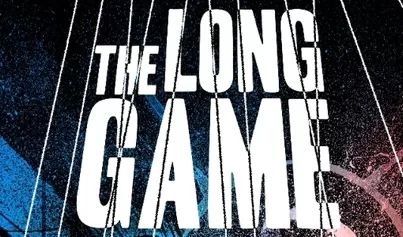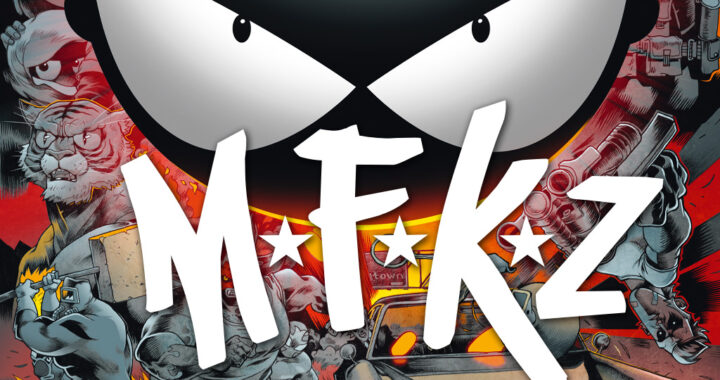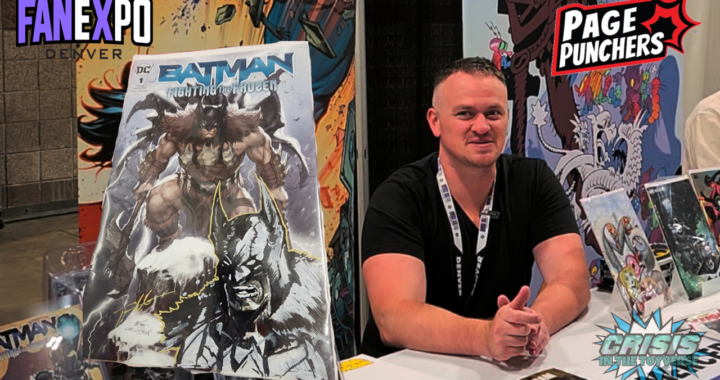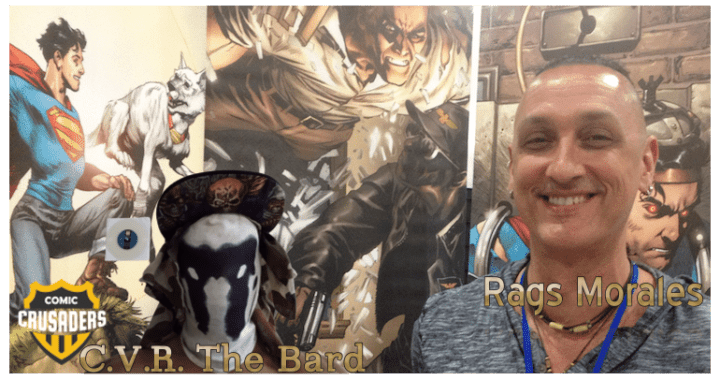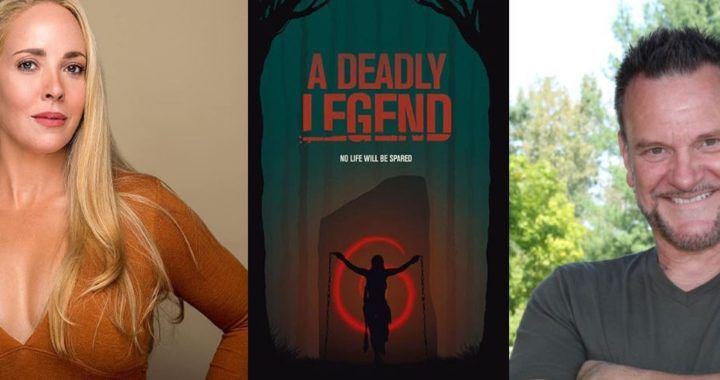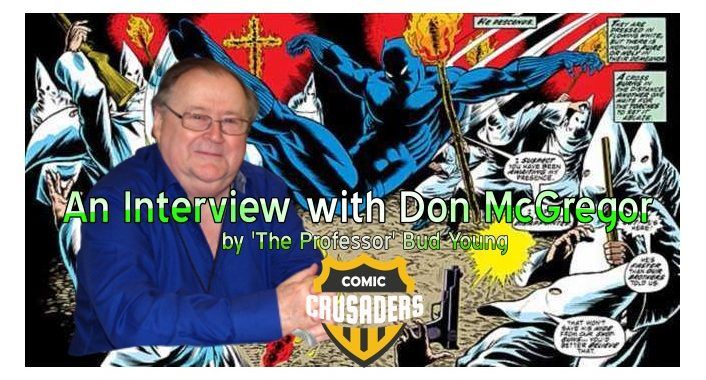
Generation Gone: A Groupchat Interview Experiment
 It all started with a Twitter thread.
It all started with a Twitter thread.I was scrolling through my often cluttered feed when a picture of the cover art for Generation Gone #2 graced my screen. I expanded it and saw several of the creators offering self-depreciating humor directed at their work. I could tell they knew how to have a good time, so I invited them all to an experimental group chat interview. It could have been a total disaster, but I was very pleased with the exchange.
Note: this conversation has been edited to encourage a linear flow of ideas, rather than a clusterf*ck of overlapping messages. You’ve been warned.
Â
 —————————————–
Robert Anderegg (Comic Crusaders):Â Hey everyone and thank you for joining me! First to aquaint ourselves, would each of you sound off with your name, creative contribution to the book, and a short highlight of past projects/ titles.
Aleš Kot: Aleš Kot, the storyteller on the book together with André, and the writer. My past projects are Zero, Secret Avengers, Change, Suicide Squad, and plenty more.
André Lima Araújo: I’m André Lima Araújo, from Portugal. I’ve worked for Marvel on stuff like Avengers A.I. and Spidey, created Man Plus and now me and Ales got together to create Generation Gone.  I’ve also recently drew an issue of The Wicked + The Divine, called 455 AD.
Chris O’Halloran:Â Chris, color monkey. I’ve been working on James Bond, Centipede and Magnus for Dynamite lately.
Clayton Cowles:Â I’m Clayton, the letterer. I’ve worked on most of Ales’s other projects, plus The Wicked + The Divine, Bitch Planet, Batman, Star Wars, Daredevil, and other stuff.
Tom Muller:Â I’m Tom, the designer. I’ve been designing comics on and off for the last 15 years, got the odd Eisner and Harvey noms along the way. I work primarily on Image books, like Zero, Wolf, Material, Surface, GG and the future The New World with Ales; Drifter, Snowfall, Motor Crush, Rockstars, etc. I also do a lot of work with Valiant, art directing, illustrating and designing covers & logos for their books including Divinity, Bloodshot Reborn (and the upcoming Salvation), X-O, etc. And I regularly design logos for DC, like the current Suicide Squad logo, Unfollow and Savage Things.
ALA:Â Tom’s bio is too big, he’s trying to be more important than all of us.
TM:Â I’ve only written down half of all the things.
RA:Â I don’t mind all the accolades. Half of a lot is still a lot, ha ha.
So, tell me, what sparked the creation of Generation Gone?
 ALA:Â Ales wrote me a note on Tumblr saying he loved my worked and wanted to do something together for Image. We started emailing and talking, figuring out what we wanted to do. My suggestions were more from an abstract point of view (I wanted to draw something big in scale but powerful in emotion) and he suggested an idea about teenagers who find something that gives them superpowers.
ALA:Â Ales wrote me a note on Tumblr saying he loved my worked and wanted to do something together for Image. We started emailing and talking, figuring out what we wanted to do. My suggestions were more from an abstract point of view (I wanted to draw something big in scale but powerful in emotion) and he suggested an idea about teenagers who find something that gives them superpowers.TM:Â I can’t remember when the Ales mentioned the idea for Generation Gone, but I think its been percolating in his brain for a while. Since we’ve been working together for a while now (since 2013 I think, when I began working on the design for Zero) ”” and I think we work well together ”” it was kind of no-brainer that we’d keep collaborating and I’d take on the design for GG.
CO: AleÅ¡ got in touch and asked me to come aboard. I jumped at the chance to work on something with all these guys I’m a fan of anyway. Pretty sure, after doing some pages, he was announcing it and showing art (days later I believe) at the Seattle show.
CC:Â I was sent two preview pages a while back and thought “I’m busy as hell, but I’ll probably end up working on this.” Now I’m working on it.
RA: Ales, You seem to be a key originator of the concept. Care to divulge how yours and André’s ideas blended together?
 AK:Â I was thinking about superhero fiction and why some of it — Stern and Romita Jr.’s run on the Amazing Spider-Man, Unbreakable, Akira, Ms. Marvel — works for me while majority of it doesn’t. And it largely came to specificity and universality combined, to a certain rawness of material rooted in actual human experience specific to the era…and then utilizing all the fascinating aspects of superhero fiction visually in new ways that got me excited. Like a breakup fight in a nuclear factory or a trip to the sun.
AK:Â I was thinking about superhero fiction and why some of it — Stern and Romita Jr.’s run on the Amazing Spider-Man, Unbreakable, Akira, Ms. Marvel — works for me while majority of it doesn’t. And it largely came to specificity and universality combined, to a certain rawness of material rooted in actual human experience specific to the era…and then utilizing all the fascinating aspects of superhero fiction visually in new ways that got me excited. Like a breakup fight in a nuclear factory or a trip to the sun.ALA:Â And based on Ales idea for the plot, I designed the characters to get us going. Â It’s also interesting how I never thought of this as a superhero book. Ales never mentioned the term while talking about the book in the early stages (unintentionally I believe) and I’ve always seen this (and drew it) more as sci-fi book.
AK:Â Plus, I asked what he wanted to do visually, so we talked about our visual and storytelling influences, what I was interested in writing and seeing and what he was interested in drawing and seeing, and that further influenced my writing approach.
ALA: Indeed. We tried to gather our interests and do something we’d both enjoy and that would fulfill us. And it did.
RA:Â So, that leads nicely into my next question. What IS Generation Gone?
 AK:Â Generation Gone is about three Millennial hackers who mess up and get superpowers. It’s about the pressures they experience in their daily lives — and how their lives are transformed. And it’s about toxic relationships, what flying feels like, and ethics in comics journalism.
AK:Â Generation Gone is about three Millennial hackers who mess up and get superpowers. It’s about the pressures they experience in their daily lives — and how their lives are transformed. And it’s about toxic relationships, what flying feels like, and ethics in comics journalism.Okay, I kid about the last part, but it definitely *is* about toxic masculinity, and also its internalization.
ALA:Â Generation Gone is about an anguished generation, people who feel at times powerless and marginalized. We imagine what would happen if they got super powers. Their problems would remain, but the solutions and possibilities at their hands would differ completely.
“If you want to see someone’s character, give them power.”
AK: Yup!
RA:Â It sounds like a really deep, culturally relevant book. Are there hints of humor or horror thrown in, or is it all in all a “superhero” drama?
AK:Â Oh, horror and awe are two big founding stones for Generation Gone for sure.
The thing is, I’m not sure if I ever wrote a book that 1) takes itself entirely seriously 100% of the time 2) is not a body horror at the very least.
ALA:Â There’s a somewhat naturalistic approach to what happens when people have super powers: it’s not very pretty. Horror and awe ensues.
AK: “Somewhat naturalistic” about sums up the last 50 pages!
ALA:Â I always approach things from a naturalistic point of view in my work. Not realistic though.
AK:Â Same. Though here I’m pointing to something rather specific, which…that would be spoilers.
ALA:Â Yes, I’m pretending you weren’t to not ruin things.
RA:Â I’d hate for you to spoil anything this far in advance! That’s an interesting distinction there, between naturalism and realism.
ALA:Â It’s a paramount distinction for me and for my work. I have little interest in realism, but naturalism is essential, in the sense of letting things flow naturally (characters, situations, concepts etc), letting things clash and see what comes of it.
And everyone relax, we’re joking, nothing is spoiled.
Or is it?
 

………………………
RA:Â Dum dum duuuuum!
ALA:Â *insert squirrel gif
RA:Â Dramatic chipmunk, actually
ALA:Â God damn you’re good.
RA:Â Thank you, the internet has been good to me.
(Tom, Clayton, Chris, I haven’t forgotten you. I’ll address each of your contributions after main story stuff is settled. If you feel the need to add any insight, please jump right in. No exclusions here!)
TM:

RA:Â So, I’m a huge fan of superheroes and how original characters can be. What can you tell us about the three hackers and their powers?
ALA:Â I’d prefer to leave specifics for the readers to discover. Though generically we can say these are three young people deeply connected personally (Ales mentions a break up in a nuclear factory, so we have a couple), but with different backgrounds, which shapes their reaction to the powers in a vastly different way.
AK:Â Elena — two jobs, barely managing to have a life. Mom’s got cancer, so she’s helping with the bills a lot. Things are stressful, but she’s still managing to be a really kind, caring person — maybe to the point of putting her own needs aside. That’s about all I’m going to give you for Elena, and that’s the only character you’ll hear from me about.
RA:Â Fair enough. I do like that you included a flying character though. Can we expect to see other standard powers like speed or super strength as well?
 

ALA:Â Well, can you?
Seriously speaking, I prefer to talk more about tone and ideas than plot points. It’s like trailers: they should be about tone/themes, not about plot. Otherwise the sense of discovery is lost.
AK:Â I mean, I don’t wanna Don Draper this interview, you know? I kinda feel like between the previews and the bits and pieces we give here, people will have a very good sense of whether they want to jump in.
RA: Okay then. In the solicits, it states “GENERATION GONE is for every kid struggling out there. It’s about what it means to be young in the USA, 2017.”
I’m in my twenties and doing a fair share of struggling. How will this appeal to my demographic?
 

AK:There’s punching and crying
ALA:Â Kissing and flying.
AK:Â Fainting and stomping!
ALA:Â There’s a lot of bleeding too.
AK: Also we’re bringing rompers back
RA:Â So long as they aren’t romp-hims… lol
AK:Â The question of whether rompers can be worn — and rocked — by man has been solved a very long time ago. In terms of popular culture, we can for example go to Sean Connery wearing one in Dr. No.
I’d wear a good romper.
ALA:Â If it’s outfits and Sean Connery, I’ll go with Zardoz.
RA: 

AK:Â I’m honestly just so freaking tired of people talking about what kinds of clothing are appropriate for whom or expressing their distaste for clothing based on gender preference. Just like, no.
RA:Â Fair point. But we’re getting off topic…
So, since we’ve covered the story at length, I wanted to discuss your individual contributions.
Aleš, where do you see this series going in the long run? Do you have a vision for the ongoing title or is Generation Gone following the Mark Millar template of a one-and-done complete story arc?
AK:Â It’s somewhere in between. Yes, each arc is its own story — but there are bigger plans than one story. Let’s just say that I’m thinking about Star Wars a lot lately.
RA:Â I guess when it comes to writing, you’re no WOOKIE!
*crickets*
RA: So, how would you describe Lizzie as an Editor?
AK:Â Lizzie is primarily *my* editor on the book — meaning that her job as an editor is mostly focused on working with me as the writer, though she points out whatever’s needed when revising the pages. This shape is something that grew out organically out of our collaboration, and she’s a great asset. Her notes make me a better writer *and* make me look better. She’s very attuned to the subtlety of GG’s characters as well as to the overarching feel of the story. All in all: blessed.
 RA: André, you’ve worked quite a bit in the superhero genre. Did you stay in that comfort zone or did the twist on this genre force you to break the mold for the story being told?
RA: André, you’ve worked quite a bit in the superhero genre. Did you stay in that comfort zone or did the twist on this genre force you to break the mold for the story being told?ALA: I’ve always told writers working with me to hold nothing back. If they think a certain thing is needed for a story, then go for it, because I will find a way to draw it, whatever it is. This is equally true for when I’m writing. Story is always, always, the number one priority. This means that, in a way, I’m always pushing and being pushed, therefore, out of my comfort zone. Generation Gone in particular is very different from traditional superhero books. As I said, I see it as a sci-fi book, so there’s that. There’s also drama and emotional scenes, that require a lot of subtlety, careful planning and acting. Those, in particular, were the toughest to draw.
RA: Chris, how would you describe the palette of this comic? Would you say it reflects the content or acts in contrast to the tone André and Aleš conveys?
CO: I guess the palette is a little muted throughout and gets crazier and stronger for certain sequences of the story. It’s still bright and poppy, mostly, but tuned down just enough to let the bigger moments shine. And yes, I suppose it’s trying to reflect AleÅ¡ and Andre’s tone as best I can or how I read it but really I’m just trying to make sure I don’t ruin the lovely work Andre has done.
RA:Â I know this is a terribly simple question, but what is your favorite color? Does it creep into your work more than others?
CO:Â Ha I do not have a favourite color though I do skew to the yellow-orange part of the spectrum in general I think for more exciting elements for most books. It’s not really about having a favourite it’s just getting the combinations right.
 RA:Â Clayton, are there any dialogue or lettering challenges you encountered? Anything outside of the ordinary?
RA: Clayton, are there any dialogue or lettering challenges you encountered? Anything outside of the ordinary?CC: I haven’t encountered any lettering challenges yet. I’ve worked with Ales and André before on numerous projects and know what to look for with both of them. Luckily for me, André prefers a simple, Orzechowskian lettering style and he leaves me plenty of space for text. Plus he draws his own sound effects, which I really appreciate.
ALA:Â Balloons are a key part of the composition and the flow of the book, it’s the job of the artist to accommodate it. I always draw them on layouts and I then send those to Clayton for him to see what I had in mind.
CC:Â Right. And even without the layouts, it’s fairly easy to interpret where Andre thinks balloons should go.
ALA:Â We make a good team.
CC:Â I think so too.
RA:Â Talking about the whole team here?
CC:Â That too.
ALA:Â Applies to everyone.
TM:
 

RA:Â Are sound effects often done by letterers? Or does the specific placement make that more difficult?
CC:Â I do the sound effects in the majority of my books. It’s cool, it’s part of the job, and it keeps me creative. But I get a special delight in seeing an artist draw their own sound effects. Yes, it saves me time, but it also adds another level of zest to the page. Being where I am in the assembly line is often limiting (usually by time), and I’m approaching sound effects from an almost purely technical standpoint, whereas I think artists (and, by extension, colorists) can bring more creativity to the craft.
André and Chris Samnee are people who do it well.
ALA:Â Yes, sound effects are a big part of the artwork. I think every artist should do them, it’s the best way to integrate them properly
RA:Â And finally, Tom. For those of us who aren’t in the know, would you mind expanding a bit on what a comic designer is responsible for?
ALA: He comes up with the package. That is, everything from the logo to credits placement, cover design (everything that I didn’t draw basically), back cover, backmatter at the end of the comic (again, all the pages I didn’t draw) it’s up to him. His choices for logo and overall design are always a reflection of the story we created, therefore a crucial part of the comic. Every element is an opportunity to tell your story, a designer like Tom assures we’re using every drop of ink to tell you something meaningful. Just look at Drifter and what a beautiful book that is. His contribution is key to it.
TM: So to recap, and follow on from what André was saying: as a designer I’m responsible to design the series logo, the cover and everything else André mentioned. What I always aim for (what I’ve done on Drifter, but also on Zero, Wolf, Material, and The Surface) is to create a consistent design that fits with the narrative and tone of the book; so that the design and experience from of the comic stays consistent.
RA:Â  Thanks for the clarification. So when wrapping up the comic into a completed, shelf-ready package, what was the biggest selling point you concerned yourself with?
Thanks for the clarification. So when wrapping up the comic into a completed, shelf-ready package, what was the biggest selling point you concerned yourself with?
 Thanks for the clarification. So when wrapping up the comic into a completed, shelf-ready package, what was the biggest selling point you concerned yourself with?
Thanks for the clarification. So when wrapping up the comic into a completed, shelf-ready package, what was the biggest selling point you concerned yourself with?TM: So in the case of GG, Ales and André wanted the cover to also be the first page of the issue, and they way the art is framed on the page was something that inspired me to look at independent magazine publishing ”“ magazines made my the millennial generation if that makes sense ”“ and use that design language for the series.
And in general, that’s what I do with all the Image books I design.
In terms of the design, I always, always want to avoid the usual comic book design tropes ”” I can be maximalist if it suits the book, but with GG, it really was a case of less is more, and go for something that doesn’t upstage the work André and Chris are doing.
RA:Â Alright, final question everyone. Before it hits comic shops on July 19th, what do you want to tell potential readers about this project?
AK:Â Generation Gone is a story I needed to make, and I’d be honored if as many readers as possible came on board and experienced it as well. I’m proud of it, I’m proud of my collaborators, and I’m proud of the rawness and beauty of human experience we’re putting into it. I sort of said this before, but looking at it now…it’s like the first seasons of SKINS meets UNBREAKABLE and AKIRA and the longer I look at it the more I’m also thinking about David Cronenberg’s work (once again) and Superman and Terrence Malick and so on and all of these influences have combined into a story I haven’t really seen — it’s a superpowers comic in a way, yes, and it’s a SF comic in a way, yes, and it’s rooted in social drama and focused on this combo of horror and awe that I’m trying to integrate from Spielberg, bit by bit…but it’s also intensely about personal relationships and the pain and release that can come with them, focused on trauma and survival and wanting more than what the world dishes out to us. Which, I think, is something many of us can relate to.
Plus, I pick the best collaborators and they pick me! I’m so so so very lucky. So it’s not just about what I did, it’s about what *we* made…a comic I’m very proud of, where everyone operates on their highest level. I hope everyone gives it a shot.
CO:Â I’d go along with that and add that all these guys have really brought their A game to bring the best comic possible and allowed me to play with the colours too.
 CC:Â I echo what everyone else says, and wish to add that everyone on the team is very nice.
CC:Â I echo what everyone else says, and wish to add that everyone on the team is very nice.TM:Â People need to buy it because it’s an exquisitely designed comic.
Gotta keep the Muller March alive
RA:Â Well said Tom, well said
TM:Â Seriously though, I’m excited to see a new comic written by Ales on the shelves.
ALA:Â Generation Gone is raw, powerful, genuine storytelling. Each one of us found room to do our thing, so you have people creating with their hearts out. And if you like original stories, that’s the best you can hope for. Generation Gone was created as our book, now it will be yours.
RA:Â Well everyone, thank you so, so much for taking the time to chat with Comic Crusaders and I highly look forward to reading the comic.
AK:Â :)Â You’re welcome! Thank you for the opportunity to talk about it with you.
ALA:Â Thanks for the talk, hugs to everyone at Comics Crusaders.
RA: But especially me, right?
ALA:Â No…Â YES!
RA:

—————————————————
Okay, I added that last gif in after the fact, not gonna lie y’all.
Be sure to preorder Generation Gone, out later this summer. Special thanks to AleÅ¡, André, Chris, Clayton, and Tom for giving such incredible responses and being so enthusiastic about taking part in my “interview”.
Preorder code for Generation Gone #1: MAY170595
Preorder code for Generation Gone #2: JUN170753

Author Profile
- Robert joined Comic Crusaders in 2016 as contributor, but has been an active online voice through social media for almost ten years. His hobbies include reading and collecting comics, attending theme parks, making music, and driving his wife insane. Deadpool and Nightcrawler are his two favorite superheroes, and while his preference is Marvel, he dabbles in every major and indie label in the comics community. He graduated from UTPB in 2013 with a BS in Mechanical Engineering and is currently seeking employment in that field. A southern boy at heart, he currently resides in the Midwest.
Latest entries
 ReviewsJune 28, 2023BOOK REVIEW: THE LONG GAME
ReviewsJune 28, 2023BOOK REVIEW: THE LONG GAME Ripe With DecayOctober 30, 2018Spooky Showdown: Mickey’s Halloween Party vs. Halloween Horror Nights
Ripe With DecayOctober 30, 2018Spooky Showdown: Mickey’s Halloween Party vs. Halloween Horror Nights InterviewsOctober 29, 2018Interview with Corey Lakel Pruitt
InterviewsOctober 29, 2018Interview with Corey Lakel Pruitt GamingJuly 17, 2018VIDEOGAME Review: Bomb Chicken
GamingJuly 17, 2018VIDEOGAME Review: Bomb Chicken
